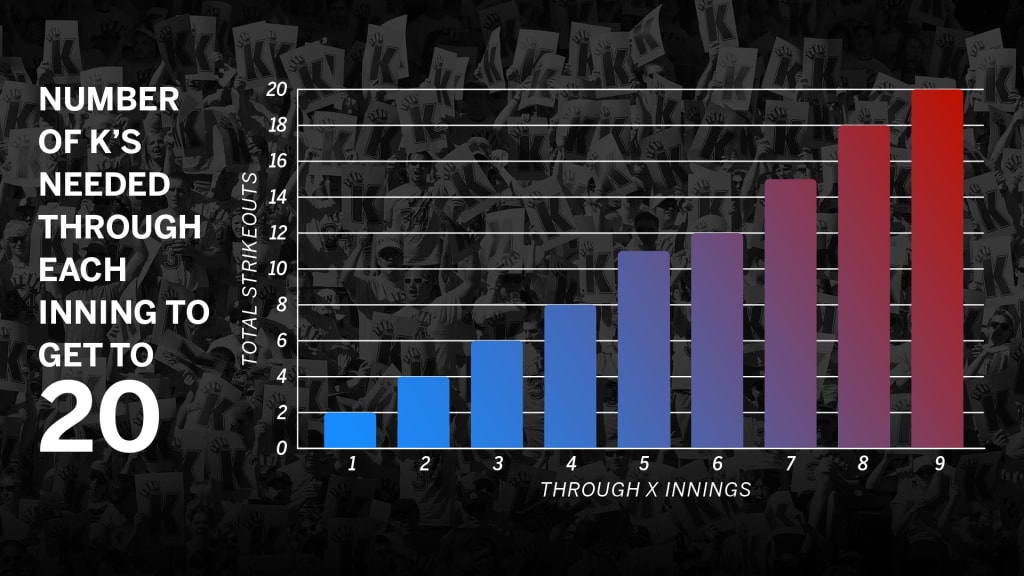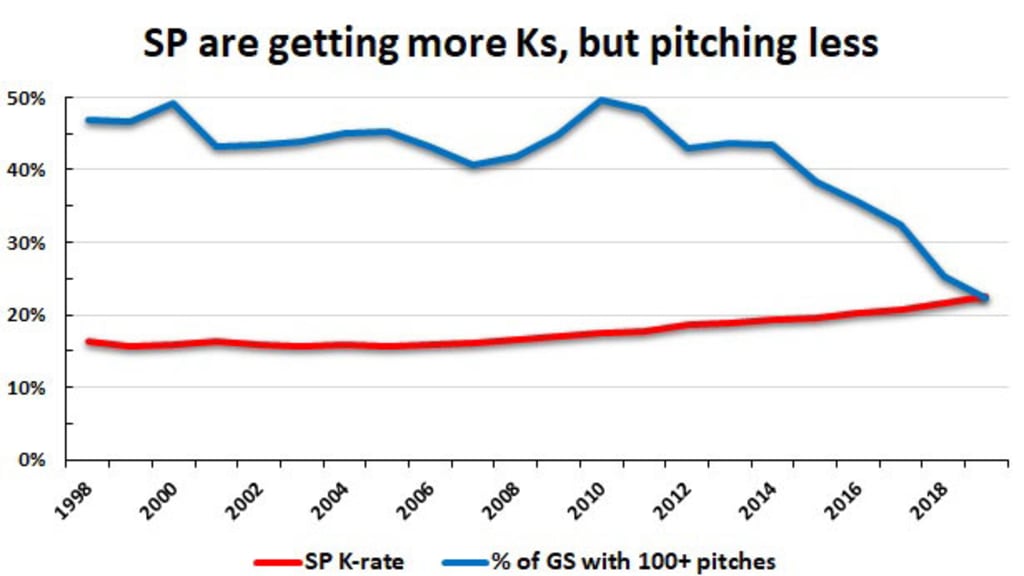Three years ago this Saturday, Max Scherzer made history with a feat more rare than throwing a perfect game, hitting four home runs, or turning an unassisted triple play.
On May 11, 2016, the Nationals right-hander struck out 20 against the Tigers, as part of a complete-game victory in Washington. It was just the fifth time a pitcher had reached the 20-K mark in nine innings, as Scherzer joined Randy Johnson, Kerry Wood, and Roger Clemens (who did it twice) in one of baseball’s most exclusive clubs.
Three years later, neither Scherzer nor any other pitcher has even come close to a repeat.
This is not to say we have seen the last 20-strikeout performance. After all, Scherzer broke a 15-year drought that makes the current one look like a blip.
Yet it is worth considering that pitchers today must navigate a road to 20 that is simultaneously tantalizing and constricting. On one hand, strikeouts are more prevalent than ever. On the other, long outings grow more and more rare. It’s a race between pitchers’ accelerating strikeout rate and their shrinking workload.
Here is a look at the path to 20 K's, the competing forces a pitcher must conquer to get there, and the candidates who might be best suited to meet that challenge.
Getting to 20
A pitcher has only 27 outs to work with on the way to this milestone, so there is little time to waste.
The five previous 20-strikeout outings don’t provide an ironclad rule for how a pitcher must get there, but they do offer a sort of guide. Here is a look at the minimum number of strikeouts the members of this select group had at the end of each inning.

The first checkpoint is not so difficult to reach. But as the outing continues, contenders begin dropping quickly. Here is how many starts have made it to each minimum, out of the more than 14,000 that had occurred since Scherzer’s 20-K game, through Wednesday.
2 K's through 1 IP: 3,360
4 K's through 2 IP: 1,378
6 K's through 3 IP: 631
8 K's through 4 IP: 320
11 K's through 5 IP: 49
12 K's through 6 IP: 68
15 K's through 7 IP: 4
18 K's through 8 IP: 0
20 K's through 9 IP: 0
In that time, just two pitchers have reached every mark, through seven innings. On May 27, 2017, Nationals righty Stephen Strasburg finished the seventh against the Padres with 15 strikeouts. And then on May 2, 2018, then-Mariners lefty James Paxton piled up 16 K's through seven against the A’s.
Both starters were pulled from the game at that point, neither one for a pinch-hitter. Yet both were over 100 pitches -- 108 for Strasburg, 105 for Paxton -- and have somewhat checkered injury histories.
And there is the biggest obstacle standing in the way of the next potential 20-K performance.
More K's, less time
Here is the good news, if you want to see this particular feat repeated: Pitchers have never been better at getting strikeouts. Starters have recorded them against 22.5 percent of the batters they have faced this season, up from last season’s single-season record of 21.6 percent. The last season when that number did not increase was 2005, when it was 15.6 percent.
Here is the bad news: With teams protecting arms and emphasizing bullpens -- not to mention using openers -- starters have a shorter leash than ever before. Let’s compare our last full season (2018) with the first of the decade (‘10), using a few different measures.
Innings per GS: Down from 6.0 to 5.4
Batters per GS: Down from 25.5 to 22.7
Pitches per GS: Down from 97 to 88
Complete games: Down from 166 to 42
% of GS with 100+ pitches: Down from 18.7% to 4.3%
% of GS with 120+ pitches: Down from 2.7% to 0.2%

Clemens threw 151 pitches in his second 20-K game, in 1996. That simply would never happen in today’s game. Even the Rocket’s 138 pitches in his first one, in ‘86, would be quite a stretch, as nobody has reached that number since Tim Lincecum’s no-hitter on July 13, 2013.
Johnson (124), Wood (122) and Scherzer (119) all had pitch counts that remain achievable in 2019 -- but not by much. Last season, just 11 pitchers hit the 120-pitch mark even once, and only the Indians’ Trevor Bauer did it multiple times.
The average strikeout eats up an average of nearly five pitches. In his 20-K start, Scherzer got that down to 4.25 pitches. But even then, 20 strikeouts requires 85 pitches, and that’s without considering the other plate appearances. There would be a minimum of seven of those (in a perfect game), and most likely more.
Scherzer faced 13 hitters he didn’t strike out, but he managed to throw them an average of just 2.6 pitches, never going longer than six in a plate appearance. Yet all it takes is a few foul balls here and a few tough calls from the umpire there, and that pitch count can stray quickly into territory that is going to make any modern manager antsy.
Who’s next?
Since Scherzer’s performance three years ago, the single-game ceiling has been 16 strikeouts, reached by Danny Duffy (Aug. 1, 2016), Jon Gray (Sept. 17, 2016), Paxton (May 2, 2018), and Gerrit Cole (May 4, 2018). The high mark this season is 14, by Jacob deGrom (April 3), Reynaldo López (April 28), and Chris Sale (May 8).
A few of those names may be a bit surprising. But it’s highly likely that if anyone is going to reach 20, it will be one of the usual suspects -- a pitcher with the stuff to rack up K's, the efficiency to do it quickly, the durability to go deep into a game, and the stature to command an opportunity to finish it.
Scherzer, of course, is one candidate. He’s done it before and remains one of the game’s top pitchers. Sale, deGrom, and Justin Verlander are obvious picks as well. Here are a few others to watch, each from the AL, where pinch-hitters don’t loom as a threat:
Cole, Astros: The 28-year-old has reached his prime as one of the game’s top strikeout artists since arriving in Houston before last season. In 2019, Cole leads MLB in K-rate (37.2 percent) and has reached 100 pitches in all but one start.
Bauer, Indians: Also 28, Bauer has completed eight innings five times since the start of 2018, and he's reached the 110-pitch plateau 15 times -- four more than any other hurler. He racks up K's with a diverse arsenal, missing bats on five different pitches. Bauer’s biggest pitfall is walks, but if he has an efficient game, he’s a threat.
Blake Snell, Rays: Snell ranks second to Cole among qualified pitchers in K-rate this season (35.2 percent), exceeding his impressive mark from 2018’s AL Cy Young Award campaign. On the other hand, the Rays have been protective of the 26-year-old, who has never gone more than 7 1/3 innings or 114 pitches. That would almost certainly have to change.
